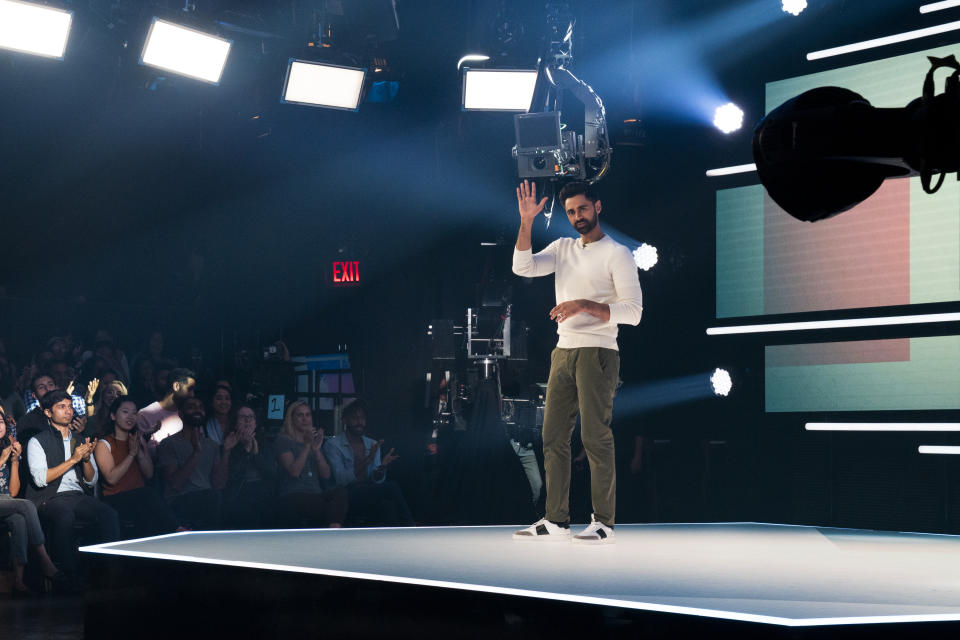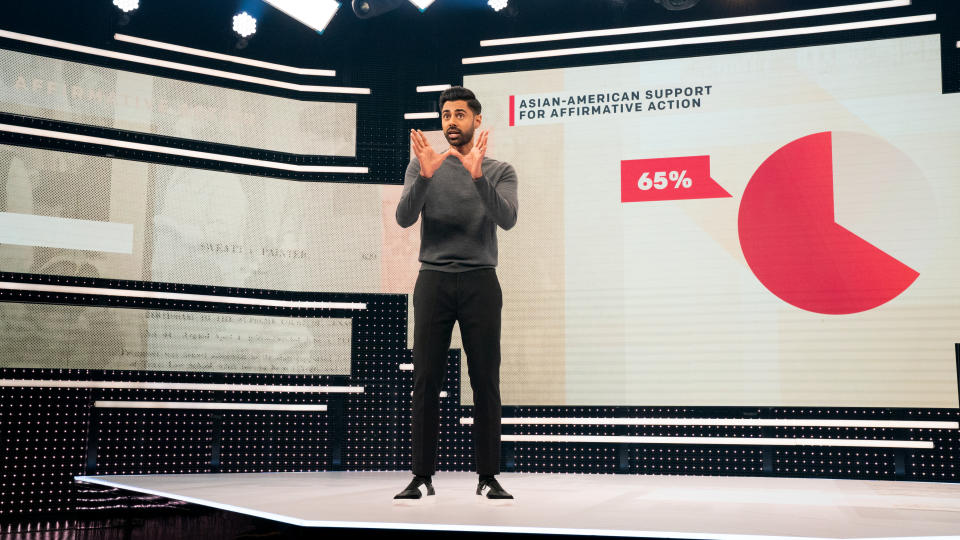‘Patriot Act’: Hasan Minhaj’s New Netflix Series Looks Different From Every Other Show on Late Night

With a title like “Patriot Act,” you might assume that the look of the latest Netflix show would revert to three basic colors. Host Hasan Minhaj had different ideas.
“Hasan from the get-go was like, ‘I don’t want it to feel like, you know, just a red, white and blue political palate. He wanted to open it up and make something a little bit more artistic and fun,” executive producer Shannon Hartman told IndieWire.
The final product that launched last Sunday (and is set for 29 more episodes under its first-of-its-kind deal for Netflix) looks a little different than the proof-of-concept idea that Minhaj self-financed. (Hartman directed that test episode, which focused on the subject of refugees, in September of last year.) “Patriot Act” creative director Michelle Higa Fox recalls that the show’s art direction style went through about 10 different versions over the intervening year.
“We landed on a look kind of inspired by microfiche film, just because we thought that that kind of layering of all different media sources would serve a deep-dive investigative show best,” Fox said. “We also did a lot of work with the color palette and to find a more modern, ownable font. We knew that we were going to have to pull in all different kinds of media and also switch on a dime from like a photoshop joke to a heartfelt sixty second monologue.”
Read More:7 New Netflix Shows to Binge in November, and the Best Reasons to Watch
There’s an agility to “Patriot Act” that also has its roots in “Homecoming King,” Minhaj’s standup special that debuted last May. Among the staffers that worked on both projects include Hartman, executive producer Michelle Caputo, “Patriot Act” co-creator and head writer Prashanth Venkataramanujam, composer Ludwig Goransson, and production/set & lighting designer Marc Janowitz. There’s an almost-interactive feel of the way Minhaj addresses his studio audience — and any viewers sitting on a couch thousands of miles away — but it also comes down to something as vital as the thing that helps them see what’s going on.
“We love these lights that we used on homecoming king called Sceptrons,” Caputo said. “They’re used a lot more in concerts for bands like Radiohead. These lights are really malleable. They can take on video, they have full dimming capacity, they can do a full spectrum of color. Nobody uses those types of things in television.”
“That’s what helps make the show certainly visually different and stand apart. Given that we’re shooting in 4K, capturing in 16-bit, using cine-style lenses helps establish the show as a more of a cinematic approach to a weekly series,” said series director Richard A. Preuss, who has an extensive resume working on live events and specials, including the Emmys, Golden Globes, and Grammys.

One major storytelling asset for “Patriot Act” is Minhaj’s backdrop: a giant top-to-floor LED screen, which allows logos, screenshots, and visual representations of data to float from behind Minhaj to below him to anywhere in between.
“The floor also being LED and being able to host graphics, we thought it would be really cool to make it like an all-immersive environment, like he’s almost in the television or in the world that he’s talking about,” Caputo said.
One tricky element of LED lighting is the Moiré effect, the scientific principle that also makes certain thin clashing patterns on clothing look like they’re being filmed through a screen door.
“One of the things we did to avoid that was get an LED wall that was 1.9 resolution, which is really high. It delivers a beautiful picture and I’m not sure the 1.9 wall’s been used in TV yet,” Caputo said.
With a crunched, weekly schedule, adding all those bar graphs, archival footage attributions, and subject-specific collages after the fact just wouldn’t be feasible. Instead the board is designed to be used and filmed live. This requires a certain amount of choreography and timing to make sure that Minhaj’s words, the visualizations behind him, and the camera movements tracking him across the stage all line up. (Preuss calls it “three-dimensional chess.”) Because the graphics team has to consider more than just making a square that can sit next to Minhaj’s shoulder, there’s an extra, constant added variable.
“We’re trying to figure out, ‘Where does Hasan stand on stage? How should the cameras frame him?’ The cameras have to frame him so that all the attributions and the data and the amazing research that the news and research team did show up. It’s an incredibly collaborative dance that we’re capturing,” Fox said.
That collaboration means departments interfacing with each other well before the cameras roll, which means that there are plenty of conversations with producers Kathryn Lord and Emily Anderson in the news and research departments, all the way across to Jaimie van Dyke and Greg Bloxham, who head up the show’s pre-visualization and program all the video components.
“Jamie and Greg run the screen and take everything from graphics and put it into the architecture,” Fox said. “There’s a lot of other people that help make that happen who are all amazing, but that pre-vis process is a crucial part of allowing everyone to see the show we’re making and for all of us to understand how are making that show before show day.”

So far, every episode has had what the show calls a “firework” moment, something that the episode is either building to or can be built around. For the graphics department, that’s key because it’s the one sequence they know they’re safe to focus on. For the show’s debut episode on affirmative action, that moment involved one particular segment highlighting the plaintiff in the pivotal 2013 Supreme Court case Fisher v. University of Texas.
“Whenever we initially get a script, we try to identify those moments and work with the writing team and say, ‘Tell us what’s definitely staying in through all of the revisions so that we can really put the love into those moments and make sure they shine,'” Fox said. “Everything is a unique moment. We have an incredibly talented, passionate staff of 10 to 12 people and everyone wears all the hats. Everyone works with news and research, does design, does the animation and it often is hopping in between episodes and sometimes even passing shots. Any single shot you see on screen may have been touched by five or six people just within graphics before it goes to screen.”
Whether giving the audience an overview of U.S.-Saudi relations or the Amazon business model, so far “Patriot Act” has offered digestible and relatable doses of massive, large-scale ideas. Doing that often requires some visual help, but how do you emphasize parts of these explanations so that it’s not overwhelming to the audience?
“There are multiple meetings with all the department heads like, ‘Do we do it as a lower third? Do we do it in the screen here or there? How do we do it so that it’s not taking the viewer out of the moment, but also that information is there for them at the same time?’ We came up with what we thought worked for our particular show, and there was a huge amount of care and mixing of expertise to figure out that answer,” Fox said.
Even at just the show’s third episode, “Patriot Act” is approaching a standardized language for talking about how these all disparate elements fit together.
“We do have a couple different glossaries and keyword terms,” Fox said. “There are things as technical as you know, style guide requirements like learning what font weight and what font size is the minimum that’s required to be legible from certain camera angles.”
With all of this care put into how it looks, “Patriot Act” is still subject to the wide array of TV viewing options. Especially when on a platform like Netflix, there’s a likely chance that many people who watch the show won’t be experiencing all of these tech innovations in their full glory. For the team, though, the emphasis is still on giving everyone the option of something that looks great, no matter the screen size.
“We’re constantly balancing that and thinking about it,” Caputo said. “But rather than limit the set because we know that a lot of people will be watching on their phones, we thought, ‘Have it look beautiful and hope that a fraction of the viewers are going to be able to watch it and enjoy it.’ Why don’t we just knock it out of the park and aim high?”
New episodes of “Patriot Act” are available Sundays on Netflix.
Related stories
The Orson Welles Film You Can See For the First Time Was His Most Personal Work

